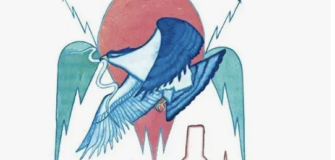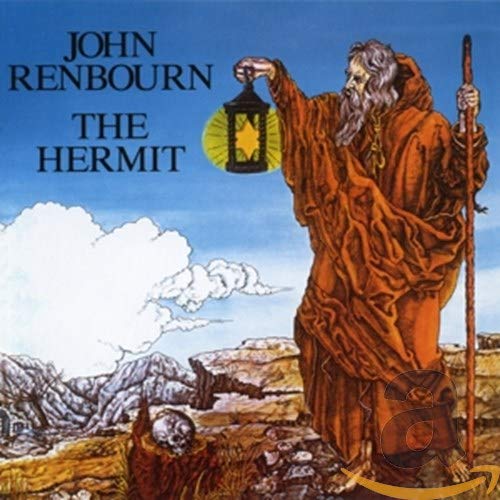Peter Green
Share

 In 1970, Carlos Santana had a huge hit with a song off his second album called “Black Magic Woman.” What American audiences may not have realized was this song was not a Santana original, but a cover of a tune written by a British blues guitarist named Peter Green, founder of the original incarnation of Fleetwood Mac.
In 1970, Carlos Santana had a huge hit with a song off his second album called “Black Magic Woman.” What American audiences may not have realized was this song was not a Santana original, but a cover of a tune written by a British blues guitarist named Peter Green, founder of the original incarnation of Fleetwood Mac.
As leader of Fleetwood Mac, Peter Green was known for the unique tone he got from his ’59 Les Paul, which was a result of the humbucking pickups in his guitar being accidentally wired out of phase.
[Gibson had dropped the Les Paul from production in 1961 and replaced it with the lighter SG to counter the popularity of the Fender Stratocaster. It was devotion to the classic Chicago blues tone of Freddie King and Hubert Sumlin by British guitarists such as Eric Clapton, Jeff Beck, Peter Green and Jimmy Page – along with Mike Bloomfield in Chicago – that led to the resurgence in the Les Paul’s popularity and its reintroduction in 1968.]
Peter Green got his first big break in 1966 when he was hired to replace Eric Clapton in John Mayall’s Bluesbreakers. He recorded one album with John Mayall called A Hard Road. It contained two of his own compositions, including a scorching instrumental called “The Supernatural.”
[B.B. King once said of Peter Green, “he has the sweetest tone I ever heard. He is the one who gave me the cold sweats.”]
While in the Bluesbreakers Peter Green met bassist John McVie. Later in 1967 he was reunited with drummer Mick Fleetwood who had previously worked with Green in a band called Shotgun Express. The trio’s first recording together was a cover of an Otis Rush song called Double Trouble.
[Double Trouble was also the name used years later by Stevie Ray Vaughan for his backup band.]
In August 1967 – after Mick Fleetwood was fired from the Bluesbreakers for getting drunk after a gig – Peter Green quit the group and recruited Mick Fleetwood and John McVie to form a new band called Peter Green’s Fleetwood Mac. Slide guitarist Jeremy Spencer was added to round out the quartet.
 Fleetwood Mac released two albums in 1968. The first, nicknamed the ‘dog and dustbin’ album, was released in February 1968. Featuring Peter Green and Jeremy Spencer performing Chicago and Delta blues in the style of B.B. King and Elmore James, it reached #4 in the UK album charts in March 1968 and stayed on the charts for thirty-seven weeks. Highlights include Jeremy Spencer’s cover of Shakey Jake’s “Shake Your Money Maker;” “Got To Move” written by Homesick James; and a Peter Green original called “I Loved Another Woman.”
Fleetwood Mac released two albums in 1968. The first, nicknamed the ‘dog and dustbin’ album, was released in February 1968. Featuring Peter Green and Jeremy Spencer performing Chicago and Delta blues in the style of B.B. King and Elmore James, it reached #4 in the UK album charts in March 1968 and stayed on the charts for thirty-seven weeks. Highlights include Jeremy Spencer’s cover of Shakey Jake’s “Shake Your Money Maker;” “Got To Move” written by Homesick James; and a Peter Green original called “I Loved Another Woman.”
Soon thereafter the band returned to the studio to cut “Black Magic Woman” and release it as a single (with a flip side of “The Sun Is Shining”). The song reached #37 in April 1968.
In July 1968, Fleetwood Mac released a cover of Little Willie John’s “Love That Burns,” which reached #31 on the charts.
 The second album, released September 1968, was titled Mr. Wonderful. In addition to the original quartet it featured the Amboy Dukes’ horn section, and keyboards by Sugar Shack member Christine Perfect. In an effort to capture the energy of a club performance, the session was recorded live in the studio with miked amplifiers and a PA system, rather than plugging the instruments into a sound board. The standout track was the Peter Green original “Rollin’ Man.”
The second album, released September 1968, was titled Mr. Wonderful. In addition to the original quartet it featured the Amboy Dukes’ horn section, and keyboards by Sugar Shack member Christine Perfect. In an effort to capture the energy of a club performance, the session was recorded live in the studio with miked amplifiers and a PA system, rather than plugging the instruments into a sound board. The standout track was the Peter Green original “Rollin’ Man.”
[In 1970 Christine Perfect married bassist John McVie, thus changing her name to become Christine McVie.]
In August 1968, eighteen-year-old guitarist Danny Kirwan (leader of the blues trio Boilerhouse) was added to the lineup primarily to help support Peter Green with his original compositions. In December he played on the Peter Green instrumental “Albatross”, which reached #1 in January 1969.
[George Harrison was so impressed with Peter Green’s guitar playing on Albatross that he patterned his guitar playing on “Sun King” for the Abbey Road album after him.]
In January 1969, Mr. Wonderful was repackaged as English Rose for release in America. It included several new compositions by Danny Kirwan, in addition to the singles “Albatross,” and “Black Magic Woman.” In August 1969, ‘The Pious Bird Of Good Omen’ (aka Albatross) was released in Britain to bundle the four singles with various album tracks.
In January 1969, while on an East Coast tour of the states, Fleetwood Mac recorded the double album ‘Blues Jam In Chicago’, at the fabled Chess Records studios. Participating in the recordings were Walter ‘Shakey’ Horton on harmonica, Buddy Guy and ‘Honey Boy’ Edwards on guitars, Otis Spann on piano, Willie Dixon on upright bass, and J.T. Brown on tenor sax.
One week later the band (sans Jeremy Spencer and Mick Fleetwood) traveled to New York to back Otis Spann on his ‘Biggest Thing Since Colossus’ album.
In June 1969, Peter Green’s melancholy single “Man of the World” reached #2 on the UK charts.
 The band’s third studio album, Then Play On, was released in September 1969. Highlights include two Peter Green originals: “Oh Well,” (their first hit in the U.S.), and the blues-rocker “Rattlesnake Shake.”
The band’s third studio album, Then Play On, was released in September 1969. Highlights include two Peter Green originals: “Oh Well,” (their first hit in the U.S.), and the blues-rocker “Rattlesnake Shake.”
Between 1968 and 1970, Fleetwood Mac outsold the Beatles in England. However, Then Play On would be Peter Green’s last album with the group. He left in May 1970 after binging on LSD at a German commune and giving away all of his possessions. He was was replaced by Christine McVie for the group’s fourth album, Kiln House, released September 1970.
*
California R&B musician Bob Welch joined the band for Future Games in 1971 after Jeremy Spencer quit the group to join a religious cult. Highlights include Danny Kirwan’s “Woman of a 1000 Years,” and “Sands of Time.” Kirwan’s last album with the band before embarking on a solo career was Bare Trees, released in 1972.
 |
 |
 |
Together, Christine McVie and Bob Welch steered the band away from their 60’s blues-rock origins into a more contemporary jazzier-rock style. They co-led the group together on five albums, highlighted by Future Games’(1971), and Bare Trees (1972).
Bare Trees included the Bob Welch original “Sentimental Lady”, and Christine McVie’s “Spare Me a Little of Your Love.” Other popular Bob Welch compositions from this period include “Hypnotized,” from Mystery To Me (1973), along with “Bermuda Triangle” and “Angel” from his last album with the group, Heroes Are Hard To Find (1974).
 |
 |
After Bob Welch left for a solo career at the end of 1974, the Los Angeles-based duo of Lindsay Buckingham and Stevie Nicks were recruited for the 1975 album Fleetwood Mac, produced by Keith Olsen. The album reached #1 in the U.S. and sold 5 million copies. In 1977, it was eclipsed by Rumours which held on to the #1 spot in the American album charts for 31 weeks, sold 40 million copies worldwide, and won a Grammy for best album.
[In an attempt to duplicate the commercial success of Fleetwood Mac, the Grateful Dead recruited producer Keith Olsen for their 1977 album Terrapin Station. It was their first recording with an outside producer since ‘Anthem to the Sun’ in 1968.]

Videos
Fleetwood Mac – Homework (Paris, 1968)
httpv://www.youtube.com/watch?v=FoV2prB6vHo&feature=endscreen
Fleetwood Mac – My Baby Sweet (Paris, 1968)
httpv://www.youtube.com/watch?v=kJGMvaippUg&feature=relmfu
Fleetwood Mac – Dust My Blues (Paris, 1968)
httpv://www.youtube.com/watch?v=XSutFqtkHTs&feature=related
Fleetwood Mac – Oh Well (Music Mash, 1969)
httpv://www.youtube.com/watch?v=0yq-Fw7C26Y
Fleetwood Mac – Rattlesnake Shake (Playboy After Dark, 1969)
httpv://www.youtube.com/watch?v=TqKKGDcexZs&feature=endscreen
Fleetwood Mac – Need Your Love So Bad (1969)
httpv://www.youtube.com/watch?v=RtmW2ek7WkQ
Fleetwood Mac – Albatross (1969)
httpv://www.youtube.com/watch?v=6ombnqWR3eA&feature=related
Fleetwood Mac – Dragonfly (1970)
httpv://www.youtube.com/watch?v=Nz2KNLMWud8&feature=related
Fleetwood Mac – Moses Lay It Down (1971)
httpv://www.youtube.com/watch?v=yhKrA-Z68Cs&feature=related
Fleetwood Mac – Woman of A Thousand Years (1972)
httpv://www.youtube.com/watch?v=Y_ZHnD3boIQ&feature=related
Fleetwood Mac – Spare Me A Little Of Your Love (1974)
httpv://www.youtube.com/watch?v=luypNhJBIFw&feature=related
Peter Green – Heavy Heart (UK TV, 1971)
httpv://www.youtube.com/watch?v=bPFEi2bIoy0&feature=related
Carlos Santana and Peter Green – Black Magic Woman (Rock and Roll Hall of Fame, 1998)
httpv://www.youtube.com/watch?v=Mj8rHPEyPU4&feature=related










Thanks. Interesting commentary with some twists to the history as I understood it. You didn’t mention Peter Green’s last album with Fleetwood Mac, Then Play On, which is a remarkable album in which you can really hear Peter pouring out his emotions.
After the infamous Munich acid experience that blew Peter’s mind, he left, and then skimmed back to the surface with a solo album called The End of the Game, which exudes melancholy. Then he faded away for years, and was never the same.